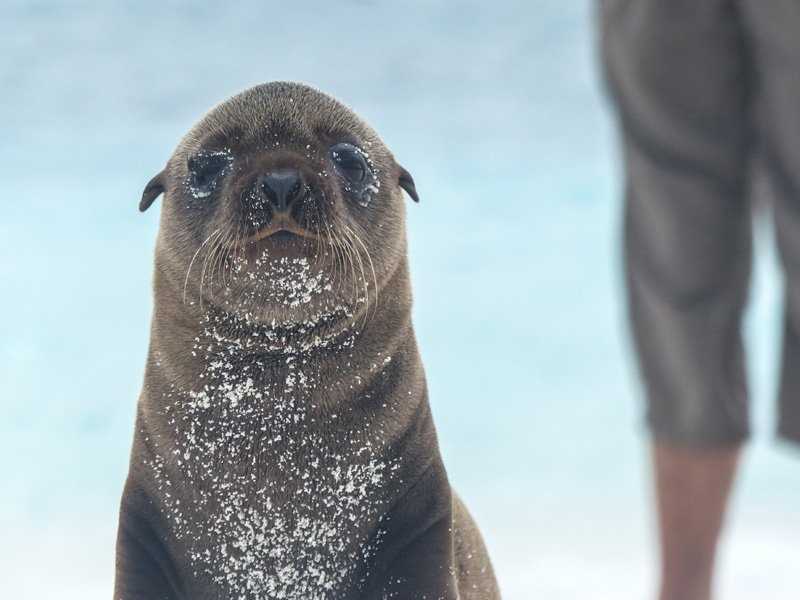What a way to start our trip! In the morning the National Geographic Endeavour was gently anchored in an azure blue bay with a low islet off to our north. To our south, a dramatic rock outcropping sat a few hundred yards off a long, bright white beach. Looking carefully, some of the small black dots on the sand could be seen moving…Galapagos sea lions!
After a briefing and outfitting session with gear, people set off in different directions. One full Zodiac left for their first Galapagos “deep-water” snorkel along the shore of Gardner Islet. The rest took off in the direction of that tempting beach and shallow blue water.
The stars of the morning turned out to be the Galapagos sea lions, of course! Wet ones, dry ones, sandy ones, males and females and pups…they are fascinating and endearing to us fellow mammals. Those that got into the water saw them pirouetting in a sea lion dance underwater, along with many bright tropical fish species, and even a sea turtle, marbled ray and white-tipped reef shark! Not bad for a first snorkel!
Espanola Island is isolated in the far southeast corner of the archipelago. As a result, the populations of organisms that found themselves here – by drifting on water or air, were genetically isolated for millennia. Today on the beach we saw the Espanola mockingbird (on our backpacks and towels), the Espanola lava lizards (darting out of the way near our feet), and the Espanola prickly pear cacti (an essential part of the island ecosystem).
The afternoon had folks following a National Park trail across the peninsula known as Punta Suarez in the west of Espanola. It was the only access to the breeding area of the Galapagos Waved Albatross – and the chicks! Looking very much like “Big Bird” of Sesame Street fame, these youngsters still have downy feathers, cannot fly, and have enormous feet. They sit erect, and stare at you in a direct gaze that expresses their innocence of anything dangerous on land.
Some adult albatross were courting, as can be seen throughout their stay on the island, from early April to the end of December. The dance is well worth changing your setting from still photography to video, as the sound of clacking bills, honks and thunks are an integral part of the dance.
Even the top predator of the islands made an appearance: the Galapagos hawk hunts normally small prey like the finches, doves and mockingbirds…but very young booby chicks are always a possibility if left unattended by the parents.
Espanola is an island of soundscapes as much as landscapes. The roaring of the “blow-hole” as sea water rushes up into the air; albatross courting with clacking bills; swallow-tailed gulls calling to each other as the sun gets lower and they prepare for a night of foraging at sea; marine iguanas snorting salt; sea lions bleating and calling; males barking.
Way better than the documentary.









